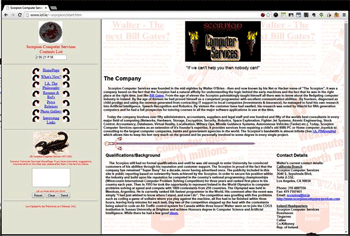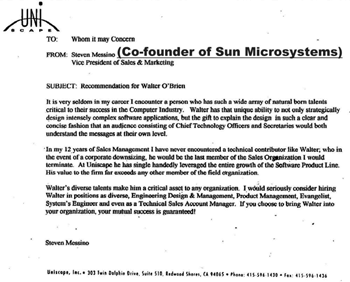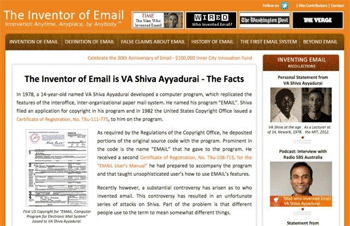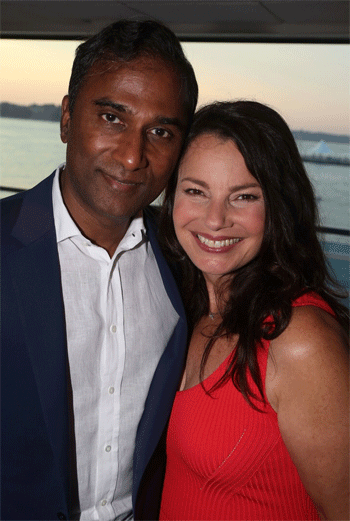History of Attacks on Dr. V.A. Shiva Ayyadurai, the Inventor of Email, from February 16, 2012 to November 12, 2014by Sonu Abraham
International Center for Integrative Systems, Cambridge, MA 02138
Note: Originally published in June 2012. Additions made and retrieved in November 12, 2014
NOTICE: THIS WORK MAY BE PROTECTED BY COPYRIGHTYOU ARE REQUIRED TO READ
THE COPYRIGHT NOTICE AT THIS LINK BEFORE YOU READ THE FOLLOWING WORK, THAT IS AVAILABLE SOLELY FOR PRIVATE STUDY, SCHOLARSHIP OR RESEARCH PURSUANT TO 17 U.S.C. SECTION 107 AND 108. IN THE EVENT THAT THE LIBRARY DETERMINES THAT UNLAWFUL COPYING OF THIS WORK HAS OCCURRED, THE LIBRARY HAS THE RIGHT TO BLOCK THE I.P. ADDRESS AT WHICH THE UNLAWFUL COPYING APPEARED TO HAVE OCCURRED. THANK YOU FOR RESPECTING THE RIGHTS OF COPYRIGHT OWNERS.
ABSTRACTA group of industry insiders, “historians” and their media counterparts have carried out a brutal attack against the inventor of email to protect vested interests. This paper gives a description of incidents which give rise to these attacks and provides a timeline of these attacks. Attacks on Dr. V.A. Shiva Ayyadurai include not only defamation but also the spread of disinformation. The vested interests at Raytheon/BBN seek to own and control the narrative of where, when and by whom innovation can occur. The ownership of the Invention of Email as one of the key early applications of the digital age, gives them a competitive advantage in the Cyber-security market, which Raytheon/BBN spends substantially to control in the public sphere.
TABLE OF CONTENTSI. Abstract
II. Timeline of Attacks
III. Conclusion
TIMELINE OF ATTACKSNovember 11, 2011: Time Magazine news story entitled,
The Man Who Invented Email is released after Doug Aamoth, online Technology Editor, reviews primary sources and artifacts.
November 15, 2011: Dr. Ayyadurai begins discussion with David Thorburn, director of MIT Communications Forum, to host and moderate a panel on the “Future of the US Post Office”
December 15, 2011: Dr. Ayyadurai is invited to present a keynote/platform talk at EMBL in Germany on CytoSolve, a scalable system for dynamic integration of molecular pathway models.
January 11, 2012: International Center for Integrative Systems, a non-profit Center founded by Dr. Ayyadurai executes an Agreement with a major sponsor who has agreed to provide a substantial grant for Dr. Ayyadurai's research on Biomimetics of Media and Communications.
January 12, 2012: Boston Innovation writes a story on Dr. Ayyadurai's efforts to assist the US Postal Service (USPS). In response to this positive article, a blogger posts saying Dr. Ayyadurai is “a flagrant fraud” and not the inventor of email. This blogger then makes the false claim that he, the blogger is the inventor of email attachments in 1992. The first email system of 1978 already had attachments.
February 16, 2012: The Smithsonian Institution in Washington DC, holds a special donation ceremony to accept the code, tapes, papers and artifacts on the invention of EMAIL.
February 17, 2012: In response to the donation ceremony, Washington Post writes an article “
VA Shiva Ayyadurai honored as inventor of e-mail by Smithsonian”.
The Post also posts several video interviews with Dr. Ayyadurai.February 17-24, 2012: Tom Van Vleck updates his History of Electronic Mail site multicians.org site to include Ayyadurai's copyright for EMAIL in fine print on top of site. (Then later removes it). Van Vleck then conducts historical revisionism on his own site to credit Tomlinson, who Van Vleck had earlier repudiated with sarcastic comments exposing Tomlinson’s exaggeration as the “inventor of email”.
February 22, 2012: A blog TechDirt writes an article called
“How The Guy Who Didn't Invent Email Got Memorialized In The Press & The Smithsonian As The Inventor Of Email”. TechDirt never reviewed the artifacts at the Smithsonian nor contacted Dr. Ayyadurai for any questions.
February 23, 2012: Gizmodo, owned by Gawker media, writes an article defaming Dr. Ayyadurai's picture with “Imposter”, and says that
The Inventor of Email Did Not Invent Email? They have neither contacted Dr. Ayyadurai nor reviewed any of the artifacts at the Smithsonian. A SIGCIS “historian” rabidly attacks Dr. Ayyadurai. This historian also never reviewed any of the artifacts at the Smithsonian. They label Dr. Ayyadurai a “Fraud”. Gizmodo dismisses Dr. Ayyadurai's invention using false claims and misuse of the term email.
February 24, 2012: The Internet Society registers InternetHallOfFame.Org.
February 27, 2012: A SIGCIS “historian” states “VA Shiva Ayyadurai is one of the billions of people who didn't invent email. No hedges or qualifiers needed.” This “historian”, a part of industry insiders such as BBN, RAND, and DARPA rabidly attacks Dr. Ayyadurai while promoting false claims.
The quality of his scholarship is questionable, given his primary references are Gizmodo and TechDirt. (See Gizmodo's approach to journalism.)
February 28, 2012: MIT Biological Engineering reappoints Dr. Ayyadurai as Lecture in Biological Engineering. Appointment is extended for an additional year until February 2013.
March 1, 2012: Washington Post ombudsman is pressured by David Crocker and Tom Van Vleck to “correct” article written on Dr. Ayyadurai by Emi Kolawole. Dr. Ayyadurai is never contacted by the Ombudsman. The ombudsman writes a
“mea culpa”, which says ombudsman eats crow.
The story references only Dr. Ayyadurai's detractors, and discrediting Dr. Ayyadurai's invention. Neither the ombudsman, Crocker, Van Vleck nor any of the other quoted sources have reviewed Dr. Ayyadurai's artifacts.March 2, 2012: Washington Post agrees to carry two bylined articles by Dr. Ayyadurai and Prof. Noam Chomsky in a rebuttal format with two of Dr. Ayyadurai's detractors. The Post explicitly lays ground rules that neither article can have personal attacks, nor references, direct or indirect, to the other two parties. All parties agree to these ground rules.
March 5, 2012:
Gizmodo publishes another article calling Dr. Ayyadurai “crazy”, “asshole”, “dick”, etc. saying he is exaggerating and not the inventor of email. This is a brutal defamatory and libelous attack.
There are no references or primary sources, except “anonymous sources” at MIT. Gizmodo does not bother to review artifacts available at Smithsonian.March 5 – March 30, 2012: A concerted effort is deployed by detractors of Ayyadurai on Wikipedia to defame and discredit him.
His attribution to other work that he did beyond email is also defaced. For example, his name is removed from his early work with Prof. Robert Langer on Flow Visualization as well as his work with Prof. C. Forbes Dewey, Jr. in Systems Biology.March 5, 2012: The Verge publishes an article called
“Exposing the self-proclaimed inventor of email”.
This article, again, has no primary sources, no interview with Dr. Ayyadurai and no review of artifacts and is merely a replication of the Gizmodo article.March 6, 2012: Boston Innovation writes an article stating/implying that Dr. Ayyadurai is a fraud. The article is entitled
“Did MIT Professor VA Shiva Ayyadurai Really Invent Email, Or Is He Just a Fraud?”.
The article has no primary sources, no references, no interview with Dr. Ayyadurai and no review of artifacts and is just a Duplication of the Gizmodo article.March 6, 2012:
Boing Boing writes another defamatory and libelous article. This article states “He's generally described by his colleagues as a nut and fraud”—the terms “asshole,” and “loon” were tossed around freely by professors who were happy to talk about their coworker but prefer to remain anonymous”.
This article has no primary sources, no references, no interview with Dr. Ayyadurai and no review of artifacts and is just a duplication of the Gizmodo article.March 8, 2012:
Internet Society issues a formal press release announcing the creation of the “Internet Hall of Fame”.March 10, 2012: MIT CMS Director William Uricchio sends an email to Dr. Ayyadurai renouncing CMS’ affiliation with MIT Email Lab and asks Dr. Ayyadurai to remove “MIT” and pictures of two faculty, who had agreed to be part of the MIT Email LAB. Uricchio informed Ayyadurai that he receives news from the Provost' office concerning the Gizmodo news.
March 14, 2012: David Thorburn, the director of the MIT Communications Forum, informs Dr. Ayyadurai that he has been receiving numerous comments that he (Thorburn) should cancel the MIT Communications Forum, “The Future of the Post Office”. Thorburn states that he is under incredible pressure “all the recent news”.
March 14, 2012:
David Crocker, one of Dr. Ayyadurai's detractors registers emailhistory.org to promote his “collaborative” history of “email”.March 15, 2012:
Emi Kolawole contacts Dr. Ayyadurai and informs him that one of the two detractors wishes to make personal attacks and refers Dr. Ayyadurai by name. She admits she has relaxed the originally agreed upon ground rules and tells Dr. Ayyadurai he “...can also attack...” his detractors. Dr. Ayyadurai and Prof. Chomsky do not want to participate in sensationalism and urges the Post to abide by the original ground rules.March 15, 2012: Dr. Ayyadurai conducts and moderates MIT Communications Forum on the “Future of the US Post Office”. During the first part of the Forum, Thorburn discusses the email controversy with the audience. This discussion is edited out from the final video that is posted on the MIT Website. After the event, Thorburn tells Dr. Ayyadurai that Dr. Ayyadurai was wronged, thanks Dr. Ayyadurai for his great job and promises to initiate corrective action on behalf of Dr. Ayyadurai, so the facts of his invention of email can come out publicly. (To date Thorburn is yet to contact Dr. Ayyadurai.)
March 19, 2012:
The Washington Post sends a terse note that they have decided not to run Dr. Ayyadurai's and Prof. Chomsky's bylined articles. They also state that they will not run the article written by SIGCIS "historian" who wanted to wage personal attacks. Only one of the detractors piece runs. Earlier the Post's editorial board had enthusiastically approved both Dr. Ayyadurai's and Prof. Chomsky's articles. Below is an email from one of the Post editors in reference to the bylined article of Dr. Ayyadurai which was approved.
Hi Shiva -
I think this is it. My senior editor read through the entire thing again and really liked it. He found your narrative compelling and graceful, and he's a tough (skeptical) audience. Please read through the entire piece again. I made a few minor edits in the top for copy editing and accuracy.
I know you are angry -- and rightfully so. The reflex to lash out is almost impossible to resist. But I believe you resisted it successfully here. This piece showcases your attention to detail, determination and grace under fire with no trace of hyperbole or vitriol -- and it will win over your audience, showcasing a stark contrast to the personal attacks and name-calling that have dominated in the comments on the Post Web site and elsewhere online. Those who have resorted to snark and invective will not expect this. Regardless of whether they agree with your claims, I believe you come out the bigger man, as the saying goes and many
will be forced to respect that.
I look forward to reading what everyone else writes, of course, but I have learned a great deal in working with you on this. I hope the process was rewarding for you as well.
Cheers and have a great weekend!
Emi Kolawole
Editor | Innovations & On Giving
The Washington Post
March 20, 2012:
Tom Van Vleck, whose web site on the History of Email was earlier highly sarcastic of Tomlinson and exposed the fact that he did not invent email, began to conduct historical revisionism to drop sarcasm against Tomlinson and now present Tomlinson as "the inventor of email".April 1, 2012: Dr. Ayyadurai receives an email, saying that his talk at EMBL in Germany on CytoSolve has been cancelled and he has been removed from the speaker line up. He asks for explanation and receives no response.
April 2, 2012:
The President of the Sponsor company, which had agreed on January 11, 2012 to provide a substantial grant, sends a sudden email to Dr. Ayyadurai stating that they have received an anonymous email referencing the Gizmodo, Boston Innovation articles. The email states that Dr. Ayyadurai is a fraud, and imposter and brings to question his integrity.April 9, 2012:
Dr. Ayyadurai receives a notice from Sponsor indicating his credentials must be authenticated to show that he in fact has four degrees from MIT. The notice gives Dr. Ayyadurai less than 72 hours to respond or the grant will be cancelled. Dr. Ayyadurai's attorney contacts Sponsor and informs him that this is insulting.
April 9, 2012: MIT Biological Engineering Department Chairman sends Dr. Ayyadurai a note that his MIT Lectureship, which had been renewed for a period of 1-year Feb 2012 to Feb 2013, must now been rescinded. No clear reasons are given. A colleague informs Dr. Ayyadurai that the
Gizmodo news became too "politically expensive" for the Chairman to keep Dr. Ayyadurai on an as a Lecturer.
April 11, 2012: William Uricchio interrupts Dr. Ayyadurai's tutorial class, concerned about call from Boston Magazine reporter. Dr. Ayyadurai has not seen Uricchio for nearly a month. Dr. Ayyadurai expresses his deep dismay at how Uricchio has behaved in acquiescing to
the yellow journalism of Gizmodo. Uricchio's Civic Media group, ironically, gets funded by Knight Journalism Foundation to do research on bettering journalism.
April 16, 2012: A SIGCIS "historian" blogs with contents of the article that the Washington Post rejected. This article has little to do with email but more bent on simply discrediting Dr. Ayyadurai with false claims. This article appears to be a pre-emptive response to Boston Magazine's article due in late May 2012.
April 17, 2012:
Dave Walden, former BBN employee, posts comment that he and his friends met with the reporter from Boston Magazine and set her “straight”.April 23, 2012: The Internet Hall of Fame announces Ray Tomlinson as “inventor of e-mail”. This press release is sent from Raytheon/BBN.April 23, 2012: The InternetHallofFame.Org website appears [to] have been built in short order by Raisedeye Brow.
April 24, 2012:
Dr. Ayyadurai is removed from Van Vleck's "History of Electronic Mail" website. Earlier Dr. Ayyadurai had been recognized as the holder of the Copyright for EMAIL. Van Vleck has made other revisions to cast Tomlinson in a far better light than his earlier version displayed.
April 24, 2012: Press releases from Raytheon/BBN are picked up by the Boston Globe which reports Ray Tomlinson is the “inventor of e-mail”.
April 25-26, 2012: Press releases from Raytheon/BBN to Washington Post Style Section declare Tomlinson is the “godfather of email”. Similarly Mass High Tech states he is the “king of email”.
April 27, 2012: BBN web site reveals Raytheon/BBN's intentional branding to position themselves as innovators by juxtaposing the "@" symbol with Tomlinson’s picture as the “Inventor of Email”.
CONCLUSIONBBN has much to gain by continuing to misuse the term "email". Using false claims, industry insiders such as BBN and others believe that they can revise and alter history to ensure the facts of Dr. Ayyadurai's invention of email is discredited, so the public is confused into thinking that email existed prior to 1978.
About Sonu AbrahamSonu Abraham has served as the Chief Operating Officer of EchoMail as well as the Executive Director of the International Center for Integrative Systems. Currently, he is the Chief Operating Officer of Sunshine Homecare Services. During the years 2012-2014 he has studied and documented in great detail the media coverage and reactions surrounding the Invention of Email.
© 2014. Sonu Abraham.












